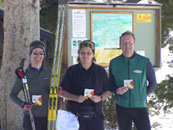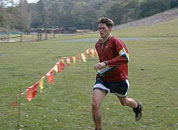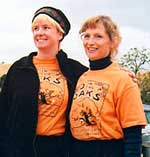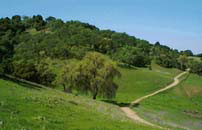
Calero Reservoir - Results
Date: Sunday, October 3, 2004
Location: Morgan Hill, CA.
Event Directors and Course Setters:
- 408.732.4818
- 408.996.8749
Type: B; White (Beginner) through Green courses, with compressed chase format for a long course than includes both the Brown and Green courses. Something for everyone!
Skip to the Results
Writeup by Dan Greene and Tapio Karras
We have to begin our account of the Calero event by thanking our volunteers. The unusual format of this event would not have been possible without plenty of volunteers. First we'd like to thank Trinka Gillis who organized the e-punch scoring for the event. About half way through the event, Evan pronounced this to be our most complicated e-punch event ever, and with good reason: it had alternate variations of courses, interval starts with a dummy control, remote field operations, and the need to produce prelude results within a few minutes of the start of the chase. On e-punch Trinka was helped by Evan Custer, Jeff Lanam, and Bjorn Widerstrom.
Related Information
RouteGadget Animation WinSplits (Stage 1) WinSplits (Stage 2) Stage 1 Splits Stage 2 Splits Reading Chase Splits Event AnnouncementEv and Jean Beuerman registered a larger than usual crowd, and Terry Farrah gave beginner clinics. Thanks also to Audrie Faist for obtaining permits, Martin Kunz, Hannu Haarma and Harold DeMoss for helping at the start, and Jim Fish, Galena and Oleg Shakhnovsky for helping at the finish. It was great to have help at the end of the day with control pick-up: Penny and Harold DeMoss, Kelly Wells, Peter Graube, Mark Blair, Rich Parker and Bill Straka.
Congratulations to the winners: "The Flaming Arrows" on White; Marta, Tomasz & Jacek Deptula on Yellow; Jackie Wong on short Orange; William Gilmore on long Orange; Parag Gupta and Beth Dixon on Brown; and Gary Carpenter and Penny DeMoss on Green. We'll return to the chase results later, after some comments on the more unusual aspects of the event.
The New Map
Since we last orienteered at Calero most of the area has been remapped by Zoran Krivokapic. Not all of the map was new, Zoran did not map areas that were deemed reasonable up-to-date. Most of courses began with their first few controls in an area mapped carefully by Bob Cooley about 7 years ago (this was also the area of the left wing of the butterfly).

White through Brown also visited the northern peninsula, which was not remapped. Altogether the orienteering map experience was significantly improved. As course setters, we found it great to have all the accurate vegetation detail---it created many more features to use for control locations and it added technical detail to otherwise bland areas.
You might have noticed the Calero map's unusual 25 foot contour interval. The Calero map was originally based on a survey map rather than a real orienteering base map. The unusual absolute accuracy of the base map let us have some fun experimenting with GPS vetting---we were able to check the accuracy of some of the control location and map features---but we found traditional vetting to be more effective. We think the large contour intervals surprised some orienteers: the contrast between the very accurate feature detail of the new map, and the missing contour detail of the base map may have been disconcerting to some orienteers.

Zoran is trying to introduce two new mapping conventions to the IOF standard, and he used these conventions when he drew the Calero map, although he left us with an OCAD file where we can change a setting and print the map with the old IOF standard. For this event we printed the map with Zoran's new conventions. The first of his innovations you almost certainly saw on your map. Down trees are shown with a symbol that indicates the direction of the trunk (although it does not show the actual extent of the trunk, like our Big Basin map). His second innovation introduces green cross-hatched lines for undergrowth that is fight. This harmonizes undergrowth with the solid green symbols for vegetation, which already have three levels: slow run, difficult to run, and fight. It seems like this new convention would be useful in the Bay Area, where we definitely have undergrowth that is fight, but the old IOF standard would have us using dark green for such areas. I don't know of any instances where this second new mapping convention was near a course, but you can see on the map and in the map key. Since we can print the map either way, let us know if you have any strong opinions about these new conventions.

The Butterfly
The Calero green course, which was also stage two of the chase, included a "butterfly" at the end of the course. A butterfly consists of two small loops, with the center control of the butterfly visited three times by the runners. Runners traverse the two "wings" of the butterfly in different orders, but will eventually traverse the same total set of legs.
Butterflies are rarely used in North American courses, although they have been appearing more frequently in major European events. We looked at some of the web discussions on butterflies before we designed the Calero butterfly. In Europe butterflies are usually used on elite courses with traditional staggered starts, where runners that make up the stagger can have a significant undesirable advantage. For this reason butterflies are usually placed later in the course, use large wings, and are located in low visibility areas, all for the purpose of separating runners that might be running together.

At Calero, our philosophy was different. We were trying to create an enjoyable pack-running event by starting the chase runners close together, so the use of the butterfly was not to prevent running together but rather to scramble runners one last time near the end of the course. Moreover, the compressed chase, with its first-to-finish order, is a good spectator course. So, unlike the usual practice, we placed the center of the butterfly in a highly visible location.
We were curious how the butterfly would work, and we saw the effects immediately. In the top three runners, Martin was able to move up one place in the butterfly. Similarly, Vlad, Evan, and Bob were able to pass competitors while their competitors were on opposite patterns in the butterfly. And about a dozen spectators enjoyed watching near the butterfly and trying to keep track of where everybody was in their multiple trips to the center of the butterfly.
The Chase
We think that the compressed chase format is unique to BAOC. First tried at Monte Bello in 2001; it's designed to create an exciting chase course, even with the smaller numbers of competitors that normally attend a local event. The 30 second fixed interval starts of the chase guarantee that everyone will have competitors near them in the chase, regardless of how well they did in the prelude. While the starts are usually "compressed" together in the chase, this does not always happen---sometimes competitors finishing with a few seconds of each other in the prelude will have their spacing expanded to 30 seconds. At Calero the attendance was unusually high, so consequently there were runners finding the 30 second interval of the chase to be larger than their spacing at the finish of the prelude.

This raises the question: what's the best strategy for the prelude? With few runners, there might be reason to conserve energy, for example, there's no sense winning by 5 minutes if you'll start only 30 seconds ahead. Conversely, with the crowds we had, there's the real possibility that a few seconds in the prelude might be rewarded with a 30 second lead in the chase, so spending energy in prelude is important. A similar analysis would apply to risk taking. Vlad, for example, concluded that the best strategy would be to go-for-broke in the prelude, knowing that the magnitude of any errors he made in the prelude would be reduced by the compression of starts in the chase.
Another aspect of the chase that is always surprising is the amount of reordering that occurs on the very first leg of the course. You'd think that 30 seconds is a large spacing, but already by the first control, 3/4 of the competitors had traded positions, with some gaining and loosing as many as 3 positions in the start order. It seems like there is less reordering in a traditional chase, even when competitors start with a few second spacing, than the amount of reordering in a compressed chase with 30 second spacing. Maybe the 30 second spacing is just large enough to force individual navigation, or maybe the 30 second spacing is just small enough to tempt runners into risky attempts to catch predecessors. Or maybe it's just the adrenaline of the start. What ever it is, there's always an enormous amount of chaos on the first leg.
Congratulations to Mattias Eriksson, a new member of the club, who won the chase. After minor mistakes in the prelude left him in fourth place, he quickly caught the lead pack in the chase, and then got ahead on the strength of a good route choice on the long green leg (4-5). You can see his routes along with commentary using RouteGadget, a new route animation tool that Tapio has imported from Finland. Check out the RouteGadget Introduction and add your own route for this event with the tool. Maybe then we can figure out just who was leading all those trains off course!
Notes Regarding the Chase
By Dan Greene
How to read the splits for the second stage of the compressed chase.
Unlike an ordinary chase, where the times of the prelude and chase are combined for an overall time, the compressed chasers are started on 30 second intervals based on the order of their finish in the prelude. The intent is to "compress" the starts together to create more head-to-head competition, although you'll notice several cases where close finishers (< 30 seconds) in the prelude were "expanded" in the chase. I guess the nearest analogy is competing for pole position in a car race, although here the advantage of start position is more significant.
The compressed chase is still a first-to-finish event, where the advantage from the prelude is carried forward in 30 second increments, rather than as an actual time. The event was timed with e-punch by giving everybody the same start time, and then having them punch a "dummy" start unit which was actually control number 221. This means that you can read the following things from the posted results:
1) The results are sorted in correct first-to-finish order.
2) To obtain your actual time on the course, you must subtract your split for the first "dummy" split reported in the results from your total time. For example, the winner, Mattias Eriksson ran the course in 33:25 - 1:29 = 31:56.
3) You can obtain your start position by dividing the first "dummy" split by thirty seconds and adding 1. For example, Mikkel Conradi, moved up five places from start position (6:30 / :30) + 1 = 14, to finish position 9.
4) All of your remaining splits are sifted by 1. For example, the center of the butterfly was first reached as the 8th control on everyone's course, but its reported as the 9th leg in the results.
5) There were two different orders for the butterfly, so you need to take care comparing the splits after the 9th split. Runners starting in odd positions (1st, 3rd, 5th) did the left wing of the butterfly first, so they will have splits for controls 241, 242, 243, 220 (center), 231, 232, 220 (center, go). While those starting in even positions (2nd, 4th, 6th) did the right wing of the butterfly first, so they will have splits 231, 232, 220 (center), 241, 242, 243, (center, go). It is easy to tell which order a runner did the butterfly by looking at their first "dummy" split time, those doing the left wing first will have first splits near whole minutes, while those doing the right wing first, will have first splits ending near :30. Everybody eventually did the same set of legs so you can rearrange the results if necessary to compare splits.
6) Because everyone had the same start time, the cumulative times in the splits correspond to when runners actually visited the controls. For example, from the splits we know that there was a pack just starting to form at control 2, with Martin (6:13) punching ahead of Mattias (6:19) and Doug (6:24). It was not yet the lead pack, and it would break apart and rearrange several times before the end of the race, but it already contained the top three finishers. You can use the cumulative times to figure out when you passed (or were passed by) your fellow competitors.
7) The regular brown course was identical to the prelude (stage 1) and the regular green course was identical to the chase (stage 2), so you can compare times and splits across the results. However, the regular green course did not use a "dummy" first control, so the splits must be shifted by one and the total times adjusted by the "dummy" first split before the chase results can be compared with the green course results.
Calero County Park
San Jose, CA
Sunday, October 3, 2004
Preliminary Results
Pl Name Time
White Course (3.5 km, 195 m climb, 12 controls)
1 Flamming Arrows: Neal & Gus Callahan,
Matt Mort, Ben Rumptz, Conner Thompson 55:17
2 Elliot & Elizabeth Clark 56:25
3 Quigley 58:20
4 Chelsea Jeanette Bearden 59:48
5 Wilkins 60:30
6 John Hanley 60:42
7 Jimmy & Mai Chung 63:22
8 Kayla Anzalone, Stephanie LaBouve 66:35
9 Matt Church 67:04
10 Teri & Caitlin Fogarty, Kelly Gardner 73:05
11 Gus Liu 73:33
12 Lauren & Teri Kent 76:40
13 Damaris Bustos, Joellyn Hamaguchi 78:27
14 Kaitlin Highstreet 81:30
15 Gray Dolphins #2: Sarah & Lee Ann Holloway,
Mary Elizabeth Bellizzi, Selinna Maefau 85:27
16 Gaye Holman 87:43
17 Raffael Porres 104:25
Landau DNF
Nelsons DNF
Yellow Course (3.1 km, 210 m climb, 12 controls)
1 Marta, Tomasz & Jacek Deptula 45:38
2 Grave 48:00
3 Shannon & Bill Cole 51:37
4 Dinesh Moorjani 52:47
5 Carl & Aleene Reisinger 62:12
6 Robin Myers, Nelson & Kimberly Rodriquez,
Tiffany & Amanda Myers-Nijmeh 66:02
7 Jeff Camillo 67:38
8 Nicole Cronin 68:24
9 Ron, Meg & Emily Thumann 72:38
10 Stacy Goss, Sue Christensen 74:36
11 Patrick Grace, Kevin Cheung 76:44
12 Brian Hart, Stephen, Jessie, Tammy, AJ 78:38
13 Doug Alexander 80:00
14 Jeff, Alex & Ana Maria Boenig 81:15
15 Tejpal Chadha, Jean Grace 81:44
16 Gray Dolphins #1: Caitlin & Peggy Stockwell,
Arianna Bellizzi, Elizabeth Graham 83:38
17 Katin 84:00
18 Hollister Pathfinder Club 89:19
19 Gerry & Carol Grismore 89:55
20 Lei Holman 92:12
21 John & Justin Surma 93:25
22 Marks 95:11
23 Quess Liu 98:38
24 Ryan & Brent Browning, Mark & Keith Jonk 106:34
25 Srikar 118:00
26 Graham Stein 140:04
Pablo Chamorro, Belen Sanchez MSP (#7)
Siddharth, Gayathn Sriram MSP (#10, #11)
Waite, Trieger DNF
Rassier DNF
Schaeffer DNF
Davidson DNF
Short Orange Course (2.4 km, 210 m climb, 10 controls)
1 Jackie Wong 1:17:56
2 Garrett Pitsenbarger 1:26:35
3 Carl & Gavin Williams 1:55:56
4 Lei Yang 1:56:42
5 Audrie Faist 2:08:52
Rajesh Kulkarni DNF
James Evans DNF
David Marwood, Joanne Thiel DNF
Brian Kirshner DNF
Harry Hall DNF
Orange Course (3.2 km, 240 m climb, 12 controls)
1 William Gilmore 54:06
2 Harold DeMoss 1:02:33
3 Lukasz Fidkowski 1:03:46
4 Eric Prestemon 1:04:09
5 Michael Sobczyk 1:04:44
6 Parag Gupta 1:06:34
7 Cynthia Sparks, Rick Norbut 1:09:38
8 Apsel Berkessel 1:14:04
9 Daniel McClure 1:16:23
10 Jeff Camillo 1:27:44
11 George Hall 1:33:09
12 Bud Laird 1:48:06
13 Alan Houser, Peter Shaw 1:59:37
14 Alexander Saltman 2:09:09
15 Sal & Al Yau 2:09:34
16 Mashno 2:13:25
17 Hammonds 2:21:14
18 Greg Heironimas 2:35:07
19 Manny Barra, Dave Shaw 3:12:59
OKeefe DNF
Nancy & Sally Smith DNF
Brown Course (2.1 km, 195 m climb, 9 controls)
1 Parag Gupta 48:42
2 Mary & Michael Fleishman 1:23:15
3 Beth Dixon 1:31:30
4 Dean French 1:32:38
5 Marc Schreiber 1:35:12
6 Jim Fish 1:39:30
7 Barbara Straka 1:47:33
8 Nancy Lindeman 2:15:10
9 Hongche & Sarah Liu 2:35:50
Green Course (3.3 km, 285 m climb, 15 controls)
1 Gary Carpenter 57:42
2 Alex Krasnov 58:06
3 Rod Jaehn 1:00:42
4 Penny DeMoss 1:08:36
5 Peter Graham 1:18:46
6 Kelly Wells 1:23:02
7 Bernhard Hiller 1:23:19
8 William Straka 1:28:58
9 Anna Zaster 1:29:43
10 Gerry Goss 1:32:13
11 Bud Laird 1:38:10
12 Denis Kourakin 1:39:58
13 Jeff Lanam 1:48:00
14 Brian Ridgway 1:50:24
15 Yelena Krasnov 1:50:54
16 Alan LaVergne 2:37:41
17 Chad Davis 3:24:02
Judy & Tom Cronin DNF
Cathy Bolger DNF
Stephanie MacLean DNF
Wes Erck DNF
Gina Christopher DNF
Rosemary Johnson DNF
Lank Kim DNF
Kristi Ridgway DNF
Phillip Hoare DNF
Chaser - Stage 1 (2.1 km, 195 m climb, 9 controls)
1 Syd Reader 19:51
2 Doug Stein 21:39
3 Martin Kunz 21:52
4 Mattias Eriksson 22:38
5 Rex Winterbottom 22:57
6 Thorsten Graeve 24:26
7 Matthias Kohler 26:56
8 Steve Gregg 27:16
9 Vladimir Gusiatnikov 28:16
10 Jonathan Owens 30:30
11 Jim Waite 30:33
12 Dan Holman 32:24
13 Werner Haag 32:39
14 Mikkel Conradi 33:54
15 Doug Bass 34:02
16 Andrejus Masalkovas 34:42
17 Derek Maclean 35:43
18 Rich Parker (SDO) 35:52
19 Ken Vomaske 38:07
20 Toby Ferguson 38:40
21 Mark Blair 40:07
22 Bob Cooley 41:52
23 Brandon Nugent (SDO) 44:11
24 Evan Custer 47:05
25 Dennis Wildfogel 48:26
26 Bjorn Widerstrom 48:39
27 Tim Dreby 48:46
28 Bill Wright 51:11
29 Joe Knapp 53:13
30 Peter Graube 54:15
31 Eric Rosenzweig 54:19
32 Dave Ingram 54:32
33 Joe Eardi 1:00:26
34 Kristi Ridgway 1:00:28
35 Mark Rice 1:01:36
36 Brian Ridgway 1:02:13
37 Chris Roper 1:03:16
38 Jennifer Kerr 1:06:19
39 Dan Dwyer 1:07:45
40 Oleg Shakhnovsky 1:08:37
41 Bob Strauss 1:21:34
42 Sean Campbell 1:25:15
Kent Ohlund DNF
J Klahn DNF
Chaser - Stage 2 (3.3 km, 285 m climb, 15 controls)
1 Mattias Eriksson 33:25
2 Martin Kunz 33:31
3 Doug Stein 33:45
4 Rex Winterbottom 41:24
5 Vladimir Gusiatnikov 42:19
6 Thorsten Graeve 42:54
7 Steve Gregg 42:55
8 Matthias Kohler 46:37
9 Mikkel Conradi 47:36
10 Jim Waite 49:02
11 Andrejus Masalkovas 49:48
12 Syd Reader 50:10
13 Werner Haag 56:30
14 Jonathan Owens 59:21
15 Doug Bass 1:00:31
16 Ken Vomaske 1:07:07
17 Dennis Wildfogel 1:10:12
18 Mark Blair 1:12:17
19 Evan Custer 1:12:20
20 Rich Parker (SDO) 1:12:25
21 Bob Cooley 1:13:42
22 Brandon Nugent (SDO) 1:13:45
23 Bjorn Widerstrom 1:16:40
24 Eric Rosenzweig 1:19:46
25 Chris Roper 1:20:51
26 Joe Eardi 1:21:01
27 Dan Holman 1:23:18
28 Tim Dreby 1:28:49
29 Bill Wright 1:30:10
30 Mark Rice 1:54:02
31 Dave Ingram 1:55:37
Oleg Shakhnovsky DNF
Peter Graube DNF
Jennifer Kerr DNF
Bob Strauss DNS
Derek Maclean DNS
Kent Ohlund DNS
Sean Campbell DNS
Brian Ridgway DNS
Joe Knapp DNS
Toby Ferguson DNS
J Klahn DNS
Dan Dwyer DNS
_______________
DNF = Did not finish (one or more controls missed)
MSP = Mispunched (one or more incorrect controls)
DNS = Did not start



